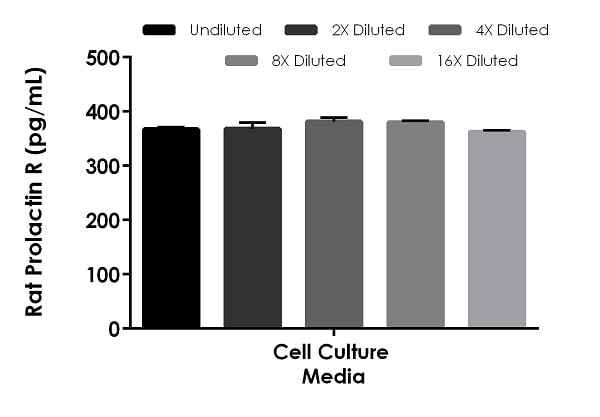Rat Prolactin Receptor / PRL-R ELISA Kit (ab238259)
Key features and details
- One-wash 90 minute protocol
- Sensitivity: 3.3 pg/ml
- Range: 12.5 pg/ml - 800 pg/ml
- Sample type: Cit plasma, EDTA Plasma, Hep Plasma, Serum, Tissue Extracts
- Detection method: Colorimetric
- Assay type: Sandwich (quantitative)
- Reacts with: Rat
Overview
-
Product name
Rat Prolactin Receptor / PRL-R ELISA Kit
See all Prolactin Receptor/PRL-R kits -
Detection method
Colorimetric -
Precision
Intra-assay Sample n Mean SD CV% Serum 5 6.3% Inter-assay Sample n Mean SD CV% Serum 3 13.1% -
Sample type
Serum, Tissue Extracts, Hep Plasma, EDTA Plasma, Cit plasma -
Assay type
Sandwich (quantitative) -
Sensitivity
3.3 pg/ml -
Range
12.5 pg/ml - 800 pg/ml -
Recovery
Sample specific recovery Sample type Average % Range Serum 78 76% - 82% Tissue Extracts 98 94% - 103% Hep Plasma 81 81% - 82% EDTA Plasma 95 91% - 101% Cit plasma 87 83% - 95% -
Assay time
1h 30m -
Assay duration
One step assay -
Species reactivity
Reacts with: Rat -
Product overview
Rat Prolactin Receptor / PRL-R ELISA Kit (ab238259) is a single-wash 90 min sandwich ELISA designed for the quantitative measurement of Prolactin Receptor / PRL-R protein in cit plasma, edta plasma, hep plasma, serum, and tissue extracts. It uses our proprietary SimpleStep ELISA® technology. Quantitate Rat Prolactin Receptor / PRL-R with 3.3 pg/ml sensitivity.
SimpleStep ELISA® technology employs capture antibodies conjugated to an affinity tag that is recognized by the monoclonal antibody used to coat our SimpleStep ELISA® plates. This approach to sandwich ELISA allows the formation of the antibody-analyte sandwich complex in a single step, significantly reducing assay time. See the SimpleStep ELISA® protocol summary in the image section for further details. Our SimpleStep ELISA® technology provides several benefits:
- Single-wash protocol reduces assay time to 90 minutes or less
- High sensitivity, specificity and reproducibility from superior antibodies
- Fully validated in biological samples
- 96-wells plate breakable into 12 x 8 wells stripsA 384-well SimpleStep ELISA® microplate (ab203359) is available to use as an alternative to the 96-well microplate provided with SimpleStep ELISA® kits.
-
Notes
Abcam has not and does not intend to apply for the REACH Authorisation of customers’ uses of products that contain European Authorisation list (Annex XIV) substances.
It is the responsibility of our customers to check the necessity of application of REACH Authorisation, and any other relevant authorisations, for their intended uses. -
Platform
Pre-coated microplate (12 x 8 well strips)
Properties
-
Storage instructions
Store at +4°C. Please refer to protocols. -
Components 1 x 96 tests 10X Rat Prolactin R Capture Antibody 1 x 600µl 10X Rat Prolactin R Detector Antibody 1 x 600µl 10X Wash Buffer PT (ab206977) 1 x 20ml 5X Cell Extraction Buffer PTR (ab193970) 1 x 10ml Antibody Diluent 4BR 1 x 6ml Plate Seals 1 unit Rat Prolactin R Lyophilized recombinant Protein 2 vials Sample Diluent NS (ab193972) 1 x 50ml SimpleStep Pre-Coated 96-Well Microplate (ab206978) 1 unit Stop Solution 1 x 12ml TMB Development Solution 1 x 12ml -
Research areas
-
Function
This is a receptor for the anterior pituitary hormone prolactin (PRL). Isoform 4 is unable to transduce prolactin signaling. Isoform 6 is unable to transduce prolactin signaling. -
Tissue specificity
Expressed in breast, placenta, kidney, liver and pancreas. -
Sequence similarities
Belongs to the type I cytokine receptor family. Type 1 subfamily.
Contains 2 fibronectin type-III domains. -
Domain
The WSXWS motif appears to be necessary for proper protein folding and thereby efficient intracellular transport and cell-surface receptor binding.
The box 1 motif is required for JAK interaction and/or activation. -
Cellular localization
Secreted and Membrane. - Information by UniProt
-
Alternative names
- AI987712
- CLONE SPM213
- CPRLP
see all -
Database links
- Entrez Gene: 24684 Rat
- SwissProt: P05710 Rat
- Unigene: 9757 Rat
Images
-
SimpleStep ELISA technology allows the formation of the antibody-antigen complex in one single step, reducing assay time to 90 minutes. Add samples or standards and antibody mix to wells all at once, incubate, wash, and add your final substrate. See protocol for a detailed step-by-step guide.
-
The Prolactin R standard curve was prepared as described in Section 10. Raw data values are shown in the table. Background-subtracted data values (mean +/- SD) are graphed.
-
The Prolactin R standard curve was prepared as described in Section 10. Raw data values are shown in the table. Background-subtracted data values (mean +/- SD) are graphed.
-
The concentrations of Prolactin R were measured in duplicates, interpolated from the Prolactin R standard curves and corrected for sample dilution. Undiluted samples are as follows: serum 50%, plasma (citrate) 50%, plasma (EDTA) 50%, and plasma (heparin) 50%. The interpolated dilution factor corrected values are plotted (mean +/- SD, n=2). The mean Prolactin R concentration was determined to be 122 pg/mL in serum, 79 pg/mL in plasma (citrate), 82 pg/mL in plasma (EDTA) and 111 pg/mL in plasma (heparin).
-
 Interpolated concentrations of native Prolactin R in rat kidney and liver tissue extract samples, samples based on a 500 µg/mL and 1500 µg/mL extract load (respectively).
Interpolated concentrations of native Prolactin R in rat kidney and liver tissue extract samples, samples based on a 500 µg/mL and 1500 µg/mL extract load (respectively).The concentrations of Prolactin R were measured in duplicate and interpolated from the Prolactin R standard curve and corrected for sample dilution and extract load. The interpolated dilution factor corrected values are plotted (mean +/- SD, n=2). The mean Prolactin R concentration was determined to be 1.2 pg/μg rat kidney tissue extract and 0.15 pg/μg rat liver tissue extract.
-
The concentrations of Prolactin R were measured in duplicates, interpolated from the Prolactin R standard curves and corrected for sample dilution. Undiluted samples are as follows: cell culture media 50%. The interpolated dilution factor corrected values are plotted (mean +/- SD, n=2).
-
To learn more about the advantages of recombinant antibodies see here.














